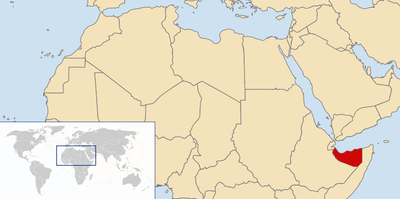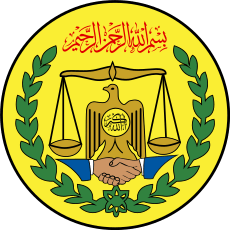State of Somaliland
The State of Somaliland was a short-lived independent country in the territory of present-day de facto independent Republic of Somaliland.[1] It was the name assumed by the former British Somaliland protectorate in the five days between June 26, 1960 and July 1, 1960, when the territory prepared for union as scheduled with the Trust Territory of Somaliland under Italian Administration (the former Italian Somaliland) to form the Somali Republic, the first incarnation of modern-day Somalia.
State of Somaliland | |||||||||
|---|---|---|---|---|---|---|---|---|---|
| 1960–1960 | |||||||||
 | |||||||||
 Location of the State of Somaliland. | |||||||||
| Status | Independent state | ||||||||
| Capital | Hargeisa | ||||||||
| Common languages | Somali | ||||||||
| Religion | Islam | ||||||||
| Prime Minister | |||||||||
| History | |||||||||
• Independence from the United Kingdom | June 26 1960 | ||||||||
| July 1 1960 | |||||||||
| Currency | Somali shilling | ||||||||
| |||||||||
Part of a series on the |
|---|
| History of Somaliland |
 |
|
|
|
|
|
|
History
In May 1960, the British government stated that it would be prepared to grant independence to the then protectorate of British Somaliland, with the intention that the territory would unite with the Italian-administered Trust Territory of Somaliland under Italian Administration (the former Italian Somaliland). The Legislative Council of British Somaliland passed a resolution in April 1960 requesting independence and union with the Trust Territory of Somaliland, which was scheduled to gain independence on 1 July that year. The legislative councils of both territories agreed to this proposal following a joint conference in Mogadishu.[2]
On June 26, 1960, the former British Somaliland protectorate briefly obtained independence as the State of Somaliland, with the Trust Territory of Somaliland following suit five days later.[3][4] The following day, on June 27, 1960, the newly convened Somaliland Legislative Assembly approved a bill that would formally allow for the union of the State of Somaliland with the Trust Territory of Somaliland on 1 July 1960.[2]
Muhammad Haji Ibrahim Egal, who had previously served as an unofficial member of the former British Somaliland protectorate's Executive Council and the Leader of Government Business in the Legislative Council, became the Prime Minister of the State of Somaliland during its planned transition to union with the Trust Territory of Somaliland under Italian Administration, the former Italian Somaliland.[5]
During its brief existence, the State of Somaliland received international recognition from 35 countries,[6] that included China, Egypt, Ethiopia, France, Ghana, Israel, Libya, the Soviet Union. The United States Secretary of State Christian Herter sent a congratulatory message,[6][7][8] and the United Kingdom signed several bilateral agreements with Somaliland in Hargeisa on June 26, 1960.[6][9]
This a copy of the letter that Secretary of State Christian Herter sent
- June 26, 1960
- Their Excellencies,
- Council of Ministers of Somaliland, Hargeisa.
- Your Excellencies: I extend my best wishes and congratulations on the achievement of your independence. This is a noteworthy milestone in your history, and it is with pleasure that I send
- my warmest regards on this happy occasion.
- Christian a. Herter
- Secretary of State,United States of America .[7]
And here is the letter that Elizabeth II send to the people of Somaliland in the independence day .
“I, my Government and my people in the United Kingdom, wish you well on this day of independence. The connection between our people goes back some 130 years and British administration of the Protectorate for 60 years. I look forward to a continuing and enduring friendship between our two countries.”[10]
There were also fears of clashes with populations in Ethiopia.[11]
On July 1, 1960, five days after the former British Somaliland protectorate obtained independence as the State of Somaliland, the territory united as scheduled with the Trust Territory of Somaliland to form the Somali Republic (Somalia).[3][4]
A government was formed by Abdullahi Issa, with Haji Bashir Ismail Yusuf as President of the Somali National Assembly, Aden Abdullah Osman Daar as President and Abdirashid Ali Shermarke as Prime Minister, later to become President (from 1967–1969). On July 20, 1961, and through a popular referendum, the Somali people ratified a new constitution, which was first drafted in 1960.[12] The constitution was widely regarded as unfair in the former Somaliland, however, and over 60% of the northern voters were against it in the referendum. Regardless, it was signed into law. Widespread dissatisfaction spread among the north's population,[13] and British-trained officers attempted a revolt to end the union in December 1961. Their uprising failed, and Somaliland continued to be marginalized by the south during the next decades.[14]
Use of state as a precedent for Somaliland
Somaliland is a self-declared sovereign state that is recognised as an autonomous region of Somalia by the international community.[15][16] Its government regards the territory as the successor state to the State of Somaliland,[17][18] and seeks self-determination as the Republic of Somaliland.[19][20][21]
References
- Somalia - British Somaliland and Somaliland
- http://wardheernews.com/Articles_09/June/Roobdoon_Forum/29_Independence_week_series.html
- Somalia
- Encyclopædia Britannica, The New Encyclopædia Britannica, (Encyclopædia Britannica: 2002), p.835
- Paolo Contini, The Somali Republic: an experiment in legal integration, (Routledge, 1969), p.6.
- http://csis.org/files/media/csis/pubs/anotes_0211.pdf
- http://www.ebooksread.com/authors-eng/united-states-dept-of-state-office-of-public-co/department-of-state-bulletin-volume-v-43-jul--sep1960-tin/page-25-department-of-state-bulletin-volume-v-43-jul--sep1960-tin.shtml
- https://history.state.gov/historicaldocuments/frus1958-60v14/d62
- THE BRENTHURST FOUNDATION Strengthening Africa’s economic performance AFRICAN GAme ChANGeR? The Consequences of Somaliland’s International (Non) Recognition
This list includes China (Republic of ), Egypt, Ethiopia, France, Ghana, Israel, Libya, Union of the Soviet Socialist Republics, United Kingdom, and the United States.
- http://www.biyokulule.com/view_content.php?articleid=1987
- "Somaliland Marks Independence After 73 Years of British Rule" (fee required). The New York Times. 1960-06-26. p. 6. Retrieved 2008-06-20.
- Greystone Press Staff, The Illustrated Library of The World and Its Peoples: Africa, North and East, (Greystone Press: 1967), p.338
- Richards (2014), p. 84.
- Richards (2014), p. 85.
- Lacey, Marc (2006-06-05). "The Signs Say Somaliland, but the World Says Somalia". New York Times. Retrieved 2010-02-02.
- "The Transitional Federal Charter of the Somali Republic" (PDF). University of Pretoria. 2004-02-01. Retrieved 2010-02-02. "The Somali Republic shall have the following boundaries. (a) North; Gulf of Aden. (b) North West; Djibouti. (c) West; Ethiopia. (d) South south-west; Kenya. (e) East; Indian Ocean."
- "Somaliland Marks Independence After 73 Years of British Rule" (fee required). The New York Times. 1960-06-26. p. 6. Retrieved 2008-06-20.
- "How Britain said farewell to its Empire". BBC News. 2010-07-23.
- "Country Profile". Government of Somaliland. Retrieved 2010-02-02.
- Schoiswohl, Michael (2004). Status and (Human Rights) Obligations of Non-Recognized De Facto Regimes in International Law. University of Michigan: Martinus Nijhoff Publishers. p. 351. ISBN 978-90-04-13655-7.
- "Regions and Territories: Somaliland". BBC News. 2009-09-25. Retrieved 2010-02-02.
Works cited
- Richards, Rebecca (2014). Understanding Statebuilding: Traditional Governance and the Modern State in Somaliland. Surrey: Ashgate. ISBN 9781472425898.CS1 maint: ref=harv (link)
External links
- The Somali Republic: an experiment in legal integration by Paolo Contini—leader of the UN Consultative Commission for Integration, which oversaw the union of the former State of Somaliland and the Trust Territory of Somaliland.
- Constitution